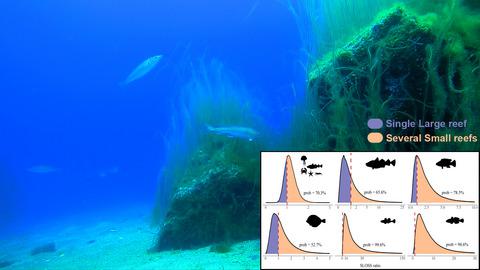当前位置:
X-MOL 学术
›
J. Appl. Ecol.
›
论文详情
Our official English website, www.x-mol.net, welcomes your feedback! (Note: you will need to create a separate account there.)
Restoring marine ecosystems: Spatial reef configuration triggers taxon-specific responses among early colonizers
Journal of Applied Ecology ( IF 5.7 ) Pub Date : 2021-09-03 , DOI: 10.1111/1365-2664.14014 Tim J.G. Wilms 1 , Pauli H. Norðfoss 1 , Henrik Baktoft 2 , Josianne G. Støttrup 1 , Bo M. Kruse 3 , Jon C. Svendsen 1
中文翻译:

恢复海洋生态系统:空间珊瑚礁配置触发早期殖民者的分类群特异性反应
更新日期:2021-09-03
Journal of Applied Ecology ( IF 5.7 ) Pub Date : 2021-09-03 , DOI: 10.1111/1365-2664.14014 Tim J.G. Wilms 1 , Pauli H. Norðfoss 1 , Henrik Baktoft 2 , Josianne G. Støttrup 1 , Bo M. Kruse 3 , Jon C. Svendsen 1
Affiliation

|
- The longstanding debate in conservation biology on the importance of single large or several small (SLOSS) habitats for preserving biodiversity remains highly relevant, given the ongoing degradation and loss of natural habitats world-wide. Restoration efforts are often constrained by limited resources, and insights from SLOSS studies therefore have important implications if restoration efforts can be optimized by manipulating the spatial configuration of restored habitats. Yet, the relevance of SLOSS for habitat restoration remains largely unexplored.
- Here, we report the effects of spatial reef configuration on early colonization of marine organisms after restoring boulder reef habitats. Reefs were restored in single large (SL) and several small (SS) designs in the western Baltic Sea, where century-long boulder extraction has severely degraded large reef areas and likely exacerbated regional declines in commercially important gadoids (Gadidae spp.). We sampled the field sites using remote underwater video systems in a before-after control-impact (BACI) design and obtained probabilistic inferences on restoration and SLOSS effects from Bayesian hierarchical models.
- Probabilities of a positive restoration effect were high (>95%) for gadoids, labrids and demersal gobies, moderate (60%–75%) for species richness and sand gobies, and low (<5%) for flatfish abundance. Notably, gadoid abundance increased 60-fold and 129-fold on average at SL and SS respectively. The species composition at restored reefs deviated from control sites, mainly driven by large-bodied piscivores.
- Spatial reef configuration had the strongest effect on small-bodied mesopredators, including gobies, which were more abundant at SS and driving distinct species assemblages between the reef designs. In addition to providing suitable conditions for reef species, results suggest that SS can also benefit soft-bottom taxa, possibly through a dispersed predator-mediated effect relative to SL.
- Synthesis and applications. This study demonstrates that boulder reef restoration can strongly promote the abundance of exploited gadoids (e.g. Atlantic cod) and is therefore a promising management tool to support top-down controls by predatory fishes in degraded marine systems. The higher abundance of mesopredators at reefs with a ‘several small’ configuration suggests that the SLOSS dilemma could have long-term implications for trophic structure and resilience of restored habitats, and should therefore become an important facet within restoration strategies.
中文翻译:

恢复海洋生态系统:空间珊瑚礁配置触发早期殖民者的分类群特异性反应
- 鉴于世界范围内自然栖息地的持续退化和丧失,保护生物学中关于单个大或几个小 (SLOSS) 栖息地对保护生物多样性的重要性的长期辩论仍然具有高度相关性。恢复工作通常受到有限资源的限制,因此,如果可以通过操纵恢复栖息地的空间配置来优化恢复工作,那么来自 SLOSS 研究的见解具有重要意义。然而,SLOSS 与栖息地恢复的相关性在很大程度上仍未得到探索。
- 在这里,我们报告了空间珊瑚礁配置对恢复巨石礁栖息地后海洋生物早期定殖的影响。在波罗的海西部,珊瑚礁以单个大 (SL) 和几个小 (SS) 设计进行了修复,那里长达一个世纪的巨石开采严重破坏了大礁石区域,并可能加剧了具有重要商业价值的鲟科 ( Gadidae spp.) 的区域衰退。我们在前后控制影响 (BACI) 设计中使用远程水下视频系统对现场站点进行采样,并从贝叶斯分层模型中获得关于恢复和 SLOSS 效果的概率推断。
- 对鲱鱼、拉比目鱼和底层虾虎鱼而言,积极恢复效果的概率较高 (>95%),物种丰富度和沙三虎鱼的概率为中等 (60%–75%),而比目鱼丰度较低 (<5%)。值得注意的是,在 SL 和 SS,gadoid 丰度分别平均增加了 60 倍和 129 倍。恢复珊瑚礁的物种组成偏离了控制地点,主要是由大型食鱼动物驱动。
- 空间珊瑚礁配置对小体型中食性动物(包括虾虎鱼)的影响最强,它们在 SS 更丰富,并在珊瑚礁设计之间驱动不同的物种组合。除了为珊瑚礁物种提供合适的条件外,结果表明 SS 还可以使软底分类群受益,这可能是通过相对于 SL 的分散的捕食者介导的作用。
- 合成与应用。这项研究表明,巨石礁恢复可以强烈促进被开发的鲱鱼(例如大西洋鳕鱼)的丰度,因此是一种很有前途的管理工具,可以支持退化海洋系统中掠食性鱼类的自上而下控制。具有“几个小”配置的珊瑚礁中较高数量的食肉动物表明 SLOSS 困境可能对恢复栖息地的营养结构和恢复力产生长期影响,因此应成为恢复策略中的一个重要方面。



























 京公网安备 11010802027423号
京公网安备 11010802027423号